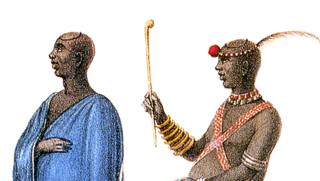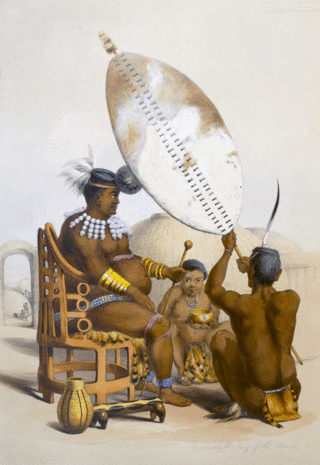
Shaka kaSenzangakhona, also known as Shaka Zulu and Sigidi kaSenzangakhona, was the king of the Zulu Kingdom from 1816 to 1828. One of the most influential monarchs of the Zulu, he ordered wide-reaching reforms that reorganized the military into a formidable force.
Nandi KaBhebhe was a daughter of Bhebhe, a past Elangeni chief and the mother of Shaka kaSenzangakhona, King of the Zulus.

The Great Trek was a northward migration of Dutch-speaking settlers who travelled by wagon trains from the Cape Colony into the interior of modern South Africa from 1836 onwards, seeking to live beyond the Cape's British colonial administration. The Great Trek resulted from the culmination of tensions between rural descendants of the Cape's original European settlers, known collectively as Boers, and the British Empire. in Cape Town. Boers who took part in the Great Trek identified themselves as voortrekkers, meaning "pioneers", "pathfinders" in Dutch and Afrikaans.

Dingane ka Senzangakhona Zulu, commonly referred to as Dingane or Dingaan, was a Zulu prince who became king of the Zulu Kingdom in 1828, after assassinating his half-brother Shaka Zulu. He set up his royal capital, uMgungundlovu, and one of numerous military encampments, or kraals, in the eMakhosini Valley just south of the White Umfolozi River, on the slope of Lion Hill (Singonyama).

Mpande kaSenzangakhona was monarch of the Zulu Kingdom from 1840 to 1872. He was a half-brother of Sigujana, Shaka and Dingane, who preceded him as Zulu kings. He came to power after he had overthrown Dingane in 1840.

Cetshwayo kaMpande was the king of the Zulu Kingdom from 1873 to 1884 and its Commander in Chief during the Anglo-Zulu War of 1879. His name has been transliterated as Cetawayo, Cetewayo, Cetywajo and Ketchwayo. Cetshwayo consistently opposed the war and sought fruitlessly to make peace with the British and was defeated and exiled following the Zulu defeat in the war. He was later allowed to return to Zululand, where he died in 1884.
King Senzangakhona kaJama was the king of the Zulu Kingdom, and primarily notable as the father of three Zulu kings who ruled during the period when the Zulus achieved prominence, led by his oldest son King Shaka.

Pieter Mauritz Retief was a Voortrekker leader. Settling in 1814 in the frontier region of the Cape Colony, he later assumed command of punitive expeditions during the sixth Xhosa War. He became a spokesperson for the frontier farmers who voiced their discontent, and wrote the Voortrekkers' declaration at their departure from the colony.
The Zulu royal family, also known as the House of Zulu consists of the king of the Zulus, his consorts, and all of his legitimate descendants. The legitimate descendants of all previous kings are also sometimes considered to be members.

Sigananda kaZokufa was a Zulu aristocrat whose life spanned the reigns of four Zulu kings in southeastern Africa. According to oral history, Sigananda's grandfather was chief Mvakela, who married a sister of Nandi, King Shaka's mother, and that his father was Inkosi Zokufa. He also said he had a son called Ndabaningi.
Dingane ka Senzangakhona Zulu, commonly referred to as Dingane or Dingaan, was a Zulu chief who became king of the Zulu Kingdom in 1828

The Zulu Kingdom, sometimes referred to as the Zulu Empire or the Kingdom of Zululand, was a monarchy in Southern Africa. During the 1810s, Shaka established a standing army that consolidated rival clans and built a large following which ruled a wide expanse of Southern Africa that extended along the coast of the Indian Ocean from the Tugela River in the south to the Pongola River in the north.

Nada the Lily is an historical novel by English writer H. Rider Haggard, published in 1892. It is said to be inspired by Haggard's time in South Africa (1875–82). It was illustrated by Charles H. M. Kerr.

uMgungundlovu was the royal capital of the Zulu King Dingane (1828–1840) and one of several military complexes which he maintained. He established his royal kraal in 1829 in the eMakhosini valley against Lion hill (Singonyama), just south of the White Umfolozi River.
The eMakhosini Ophathe Heritage Park is a nature reserve located about 10 km south of Ulundi in the KwaZulu-Natal province of South Africa, and lies on the banks of the White Umfolozi River. It means to recapture the cultural heritage of the Zulu people, and natural landscape of the valley at the time of King Shaka. The park has an area of 24,000 ha.
Sigujana kaSenzangakhona was King of the Zulu people in 1816. He was the son of Senzangakhona kaJama and half-brother of Dingane kaSenzangakhona and Shaka kaSenzangakhona. He succeeded his father c. 1816. His mother was Bhibhi kaSompisi. Shortly after he became chief, he was murdered by his half-brother, Shaka. It is disputed whether Shaka had him assassinated, or Shaka himself killed Sigujana by stabbing him. His birth date is unknown, but he died in 1816, shortly after he had become King.

The Piet Retief Delegation massacre was the 1838 killing of 100 Voortrekkers by the Zulu king Dingane in what is now KwaZulu-Natal, South Africa. The Voortrekkers, led by Piet Retief, migrated into Natal in 1837 and negotiated a land treaty in February 1838 with Dingane. Upon realizing the ramifications of the imposed contract, Dingane betrayed the Voortrekkers, killing the delegation including Retief on 6 February 1838. The land treaty was later found in Retief's possession. It gave the Voortrekkers the land between the Tugela River and Port St. Johns. This event eventually led to the Battle of Blood River and the eventual defeat of Dingane.
Princess Mkabayi kaJama was a Zulu princess, the head of the Qulusi military kraal, and a regent of the Zulu Kingdom. She persuaded her father, the Zulu King Jama kaNdaba, to remarry, and acted as a regent during the reign of her half-brother, Senzangakhona.
Mthimkhulu II was King of the AmaHlubi people, a Bantu Kingdom from Southern Africa. He succeeded his father King Bhungane II,("Bhungan'omakhulukhulu") in the year 1801 and thus becoming the King of AmaHlubi nation to rule in what is now known as KwaZulu-Natal as the Kingdom can trace its lineage to Great Lakes of Africa then later in the Lebombo mountains area.













